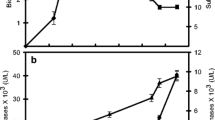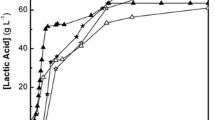Abstract
One of the most important problems in the design and operation of fixed-bed biological reactors is the control of the process rate by mass-transfer limitations. In order to overcome this problem, a new technology, based on the use of pulsed reactors, was developed. A new type of pulsing device, giving a see-saw-type of disturbance, was assayed. To quantify the possible improvement obtained, we have chosen as an example the hydrolysis of concentrated starch solutions by glucoamylase (fromAspergillus niger) immobilized on chitin slabs. The reactor has an internal diameter of 50 mm and a bed height of 200 mm. Temperature was controlled at 25°C, and the working hydraulic retention times were from 0.29 to 1.8 h. The results revealed that pulsation helps to lessen the diffusional difficulties, since the maximum reaction velocity increased 10%. Additional improvements, up to 20% in some cases, are achieved by recycling a part of partially converted feed.
Similar content being viewed by others
Abbreviations
- τ:
-
mean residence time h
- So, S:
-
initial and final substrate concentration g/L
- r=V:
-
hydrolysis rate g/L.min
- Vmax :
-
maximum reaction rate g/L-min
- K s :
-
Michaelis constant g/L
- R :
-
recirculation rate = return flow/out flow
- t :
-
time h
- θ:
-
normalized time
- D :
-
axial dispersion coefficient m2/s
- N :
-
number of tanks in series
- C θ :
-
normalized tracer response to a pulse input
- µ a :
-
apparent viscosity kg/m.s
- - dv/dr :
-
velocity gradient s-1
References
Srinikethan, G., Prabhakar, A., and Varma, Y. B. G. (1987),Bioprocess Eng. 2, 161–168.
Finnigan, S. M. and Howell, J. A. (1989),Chem. Eng. Res. Des. 67, 278–282.
Hwang, K.-Y. and Brauer, H. (1987),Biotech Forum 4, 3, 118–130.
Etzold, M. and Stadlbauer, E. A. (1990),Bioprocess Eng. 5, 7–12.
Hamamci, H. and Ryu, D. D. Y. (1988),Appl. Microbiol. Biotechnol. 28, 515–519.
Ghommidh, C, Navarro, J. M, and Durand, G. (1982),Biotechnol. Bioeng. 24, 605–617.
Baird, M. H., Vijayan, S., Rama Rao, N. V., and Rohatgi, A. (1989),Can. J. Chem. Eng. 67, 787–800.
Murthy, V. V. P. S., Ramachandran, K. B., and Ghose, T. K. (1989),Process Biochem. 4, 77–83.
Navarro, J. M. and Goma, G. (1980),Nouveau dispositif de Mise en Oeuvre des Micro-Organismes. Brevet d’invention n°78 28572, Institut National de la Propriété Industrielle. Paris.
Bouzas, S., Casares, J. J., and Lema, J. M. (1988), Ingeniería Química234, 209–214.
Bouzas, S., Casares, J. J., and Lema, J. M. (1988), Ingenieria Quimica237, 115–120.
Bernfeld, D. P. (1951),Adv. Enzymol. 12, 379–427.
Bunday, B. D. (1984),Basic Optimization Methods (E. Arnold Pu, London).
Stanley, W. L., Watters, G. G., Kelley, S. H., and Olson, A. C. (1978),Biotechnol. Bioeng. 20, 135–140.
Synowiecki, J., Sikorski, E., Naczk, M., and Piotrzkowska, H. (1982),Biotechnol. Bioeng. 24, 1871–1876.
Miranda, M., Murado, M. A., Sanromán, A., and Lema, J. M.Enzyme Microb. Technol. (in press).
Author information
Authors and Affiliations
Rights and permissions
About this article
Cite this article
Sanromán, A., Chamy, R., Núñez, M.J. et al. Enzymatic hydrolysis of starch in a fixed-bed pulsed-flow reactor. Appl Biochem Biotechnol 28, 527–538 (1991). https://doi.org/10.1007/BF02922631
Issue Date:
DOI: https://doi.org/10.1007/BF02922631




